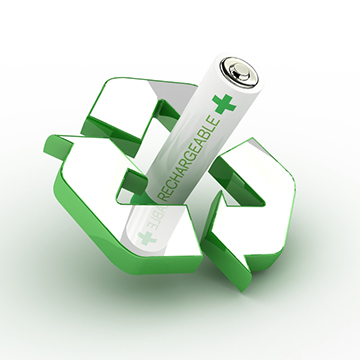
What are rechargeable batteries?
Rechargeable batteries are batteries you use more than once, and they power the devices we use every day. You can either plug rechargeable batteries into a charger, or they charge while in the device. Some rechargeable batteries can contain potentially harmful materials, such as heavy metals like lead, cadmium and nickel. Rechargeable batteries should always be recycled, and in some states or provinces, recycling is the law.
Below is a list of rechargeable battery chemistries:
- Nickel cadmium (Ni-Cd)
- Nickel metal hydride (Ni-MH)
- Nickel zinc (Ni-Zn)
- Lithium ion (Li-Ion)
- Small sealed lead acid (SSLA/Pb)
What are the most common products using rechargeable batteries?

You will find that many common household and small cordless electronics are powered using rechargeable batteries.
Ni-Cd rechargeable batteries are found in cordless power tools, cordless phones, digital cameras, video cameras, two-way radios and biomedical equipment. Li-Ion rechargeable batteries are commonly located in cell phones, cordless power tools, laptop computers, tablets and e-readers and two-way radios. SSLA/Pb rechargeable batteries power such devices as mobility scooters, fire emergency tools, UPS back-up systems, hospital equipment and exit signs.
How are rechargeable batteries recycled?
Rechargeable batteries can be
recycled into new batteries or new products. Batteries are collected at various locations, such as major retailers, community recycling centers, small businesses and government offices and are then sent to battery processing facilities for sorting and processing. Batteries are arranged by chemistry and treated at specific processors in the U.S. and Canada depending on their chemistry. The processors extract useable chemicals and metals to be applied in the manufacturing of new batteries and products. Responsible recycling practices and standards are governed by such organizations as
Sustainable Electronics Recycling International and the
Basal Action Network and ensure materials are properly managed.
Key components of these programs include:
- Waste products responsibly and safely disposed of in North America
- Nothing disposed of in a landfill
- No waste materials from the recycling process exported out of the country
What happens to the used batteries when recycled?
- Used Ni-Cd, Ni-MH and Ni-Zn batteries are recycled into new products such as silverware, pots and pans, golf clubs and new batteries
- Used Li-Ion batteries are recycled into steel, stainless steel and new batteries
- Used SSLA/Pb batteries are recycled into new Pb-based batteries
For a look at how Call2Recycle recycles your rechargeable batteries, click here.

 You will find that many common household and small cordless electronics are powered using rechargeable batteries.
Ni-Cd rechargeable batteries are found in cordless power tools, cordless phones, digital cameras, video cameras, two-way radios and biomedical equipment. Li-Ion rechargeable batteries are commonly located in cell phones, cordless power tools, laptop computers, tablets and e-readers and two-way radios. SSLA/Pb rechargeable batteries power such devices as mobility scooters, fire emergency tools, UPS back-up systems, hospital equipment and exit signs.
You will find that many common household and small cordless electronics are powered using rechargeable batteries.
Ni-Cd rechargeable batteries are found in cordless power tools, cordless phones, digital cameras, video cameras, two-way radios and biomedical equipment. Li-Ion rechargeable batteries are commonly located in cell phones, cordless power tools, laptop computers, tablets and e-readers and two-way radios. SSLA/Pb rechargeable batteries power such devices as mobility scooters, fire emergency tools, UPS back-up systems, hospital equipment and exit signs.